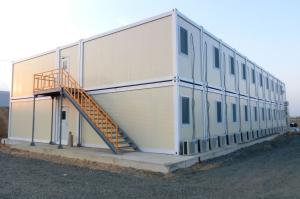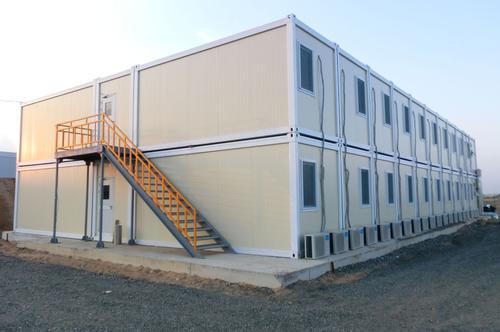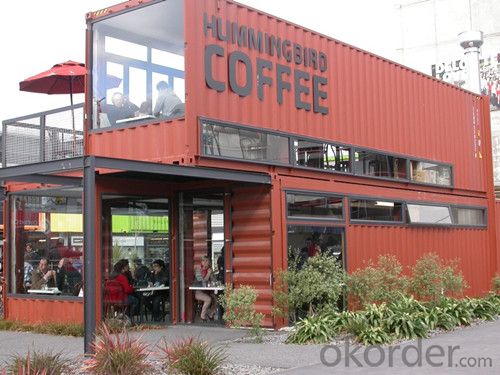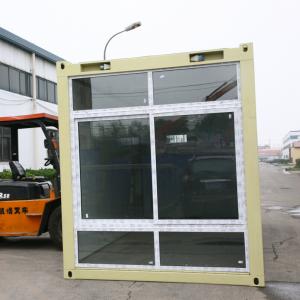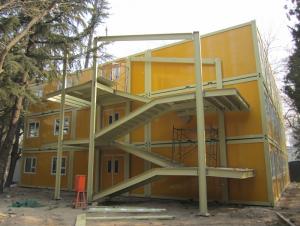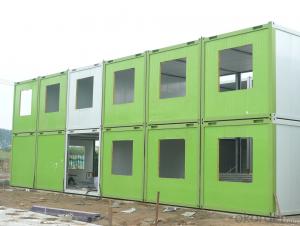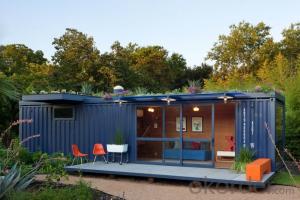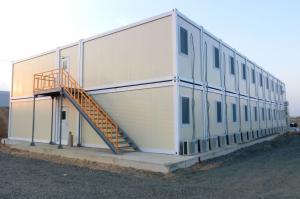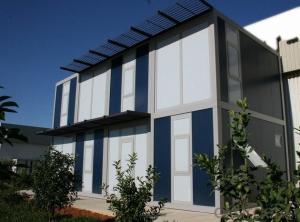Good Quality Container House for Australia with Great Price
- Loading Port:
- Tianjin
- Payment Terms:
- TT OR LC
- Min Order Qty:
- 3 set
- Supply Capability:
- 300 set/month
OKorder Service Pledge
OKorder Financial Service
You Might Also Like
Good Quality Container House for Australia with Great Price
1. The benefits of Container House
Perfect for modular/prefab site offices,cabins,warehouse,villa,toliet,shop,hotel,camp,office
Efficient, low cost designs that can be customized for end user requirements
Easy for low skilled workers to assemble
The light steel frame structure is strong and reliable
Many modular homes can be stacked and linked together to create more space
Neat inside: plumbing and wires are hidden into the sandwich panel
2. Certificates:
ISO9001, ISO14001, CSA(Canadian Standards Association), CE(European Conformity), AU(Australia Standard),UL(America standard)
3. Specification:
Item | Specification |
Frame | Cold formed 3-4mm Steel Profile Wind resistance capacity>120km/h, Seismic resistance capacity > grade 8 |
Floor | ·0.5 mm flat galvanized steel sheet ·100mm non combustible mineral wool ·18mmplywood panel ·Customized PVC floor |
Roof | 0.5mm galvanized &painted steel sheet ·100mm non combustible mineral woo ·one set CE electronic installation |
Door | ·Single fold, 40mm thick ·Insulated with PL (polystyrene) · Opening dimensions of 808×2030mm, with a handle lock with 3 keys. · Net opening dimensions: 754 x 1985 mm. |
Wall panel | ·0.5mm galvanized &painted steel sheet ·60mm rock wool ·9mm chipboard |
Window | Made of PVC, white color, with dimensions 800×1100mm, glazed with double layer glass with sliding mechanism (one side fixed and one sliding). More extra types chosen in term of your specific needs. |
The cabin can be dis-assemebled for transport.
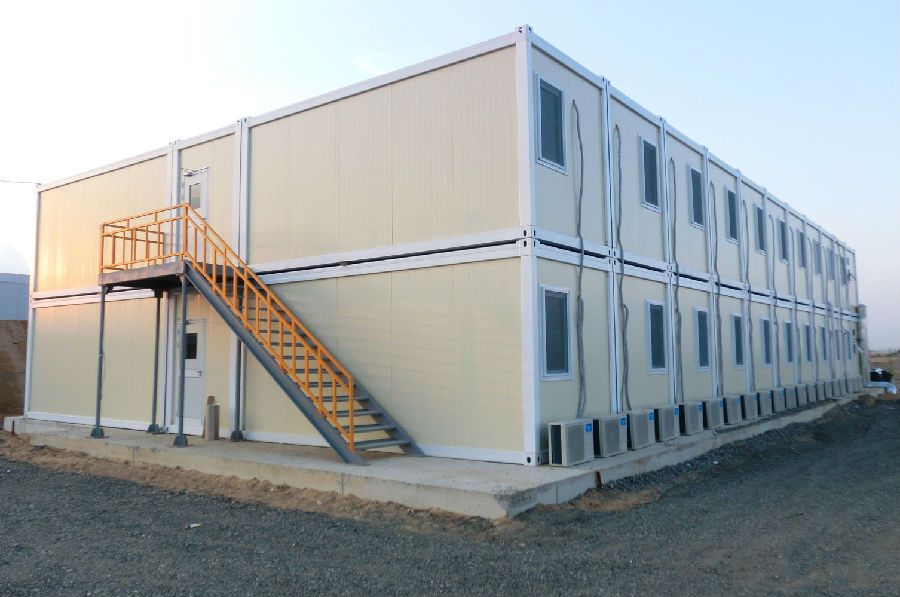
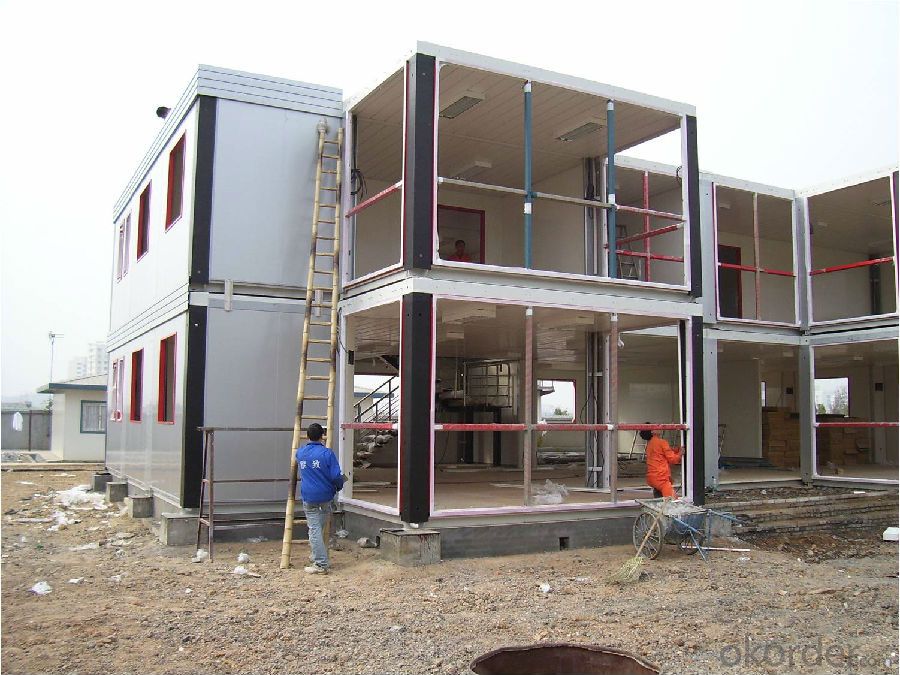
- Q: Are container houses considered sustainable housing options?
- Yes, container houses are considered sustainable housing options. Container houses are made from repurposed shipping containers, which reduces the demand for new construction materials and helps to reduce waste. By using these recycled containers, fewer resources are consumed and less energy is required compared to traditional construction methods. Additionally, container houses can be designed to be energy-efficient by incorporating insulation, solar panels, and other eco-friendly technologies. They can also be easily transported, allowing for flexibility and minimizing the need for new construction in different locations. Overall, container houses offer a sustainable alternative to traditional housing options.
- Q: Can container houses be designed to have a laundry room?
- Yes, container houses can definitely be designed to have a laundry room. The interior layout and design of container houses can be customized to accommodate various functional spaces, including a dedicated area for laundry. By strategically planning the placement of plumbing, electrical connections, and appliances within the container, it is entirely feasible to integrate a laundry room into the design.
- Q: Are container houses resistant to pests and insects?
- Container houses are known for their general resistance to pests and insects. This is because they are constructed using steel or aluminum, which makes their exteriors highly durable and tough for pests to infiltrate. Furthermore, container homes have tight seals and limited openings, making it more challenging for pests and insects to enter. Nevertheless, it's crucial to acknowledge that no house is entirely immune to pests, and occasional infestations may still happen. To guarantee the ongoing pest and insect resistance of container houses, regular maintenance such as sealing cracks and monitoring for signs of pest activity is strongly advised.
- Q: Can container houses be designed with rooftop gardens?
- Yes, container houses can definitely be designed with rooftop gardens. In fact, container houses provide a great opportunity for incorporating rooftop gardens due to their structural integrity and flexibility. By utilizing the flat surface of the container roof, it is possible to create a thriving garden space that not only enhances the aesthetic appeal of the house but also offers several benefits. Rooftop gardens in container houses can help regulate indoor temperatures by providing insulation and reducing heat transfer. The plants and soil act as a natural barrier, preventing excessive heat from penetrating the house during hot weather and also providing insulation during colder months. This can significantly reduce energy consumption and lower utility bills. Furthermore, rooftop gardens contribute to improving air quality and providing a source of fresh produce. Plants absorb carbon dioxide and release oxygen, thus purifying the air and creating a healthier living environment. Additionally, container houses with rooftop gardens can grow vegetables, herbs, or even fruits, allowing homeowners to have a sustainable food source right at their doorstep. Designing a rooftop garden for a container house requires careful consideration of weight distribution, irrigation systems, and plant selection. Lightweight materials should be used to minimize the load on the container's roof, while efficient irrigation systems such as drip irrigation can ensure that plants receive adequate water without wasting it. Additionally, choosing plants that can thrive in the rooftop environment, such as succulents or drought-tolerant species, can make maintenance easier and more sustainable. In conclusion, container houses can indeed be designed with rooftop gardens, offering numerous benefits including improved insulation, reduced energy consumption, enhanced air quality, and access to fresh produce. With proper planning and design, rooftop gardens can transform container houses into sustainable and eco-friendly homes.
- Q: How do container houses compare to traditional houses in terms of insulation?
- Compared to traditional houses, container houses typically have less effective insulation. This is primarily due to the materials used in their construction. Traditional houses are typically built using various insulating materials like fiberglass, foam, or cellulose insulation, which greatly assist in reducing heat transfer and maintaining a pleasant indoor temperature. Conversely, container houses are mainly constructed with steel, which has poor insulation properties. Nevertheless, it is worth noting that insulation can be added to container houses to enhance their thermal performance. Insulating materials like spray foam insulation or rigid foam boards can be installed on the container's interior or exterior walls to improve insulation. Moreover, double-glazed windows and doors can be utilized to minimize heat loss or gain. Despite these insulation enhancements, container houses may still struggle to match the insulation capabilities of traditional houses. This is because the fundamental structure of a shipping container, with its metal walls and roof, inherently allows for more heat transfer in comparison to a well-insulated traditional house. In conclusion, while modifications can be made to improve the insulation of container houses, they generally fall behind traditional houses regarding thermal performance. Nevertheless, by incorporating appropriate insulation materials and techniques, container houses can still offer sufficient insulation for comfortable living conditions.
- Q: Are container houses suitable for daycare or childcare centers?
- Container houses can indeed be suitable for daycare or childcare centers. These houses are known for their versatility and adaptability, making them a viable option for various purposes, including childcare facilities. Container houses can be easily customized and transformed into functional, safe, and welcoming spaces for children. With proper insulation, ventilation, and soundproofing, container houses can provide a comfortable and secure environment for children to learn and play. Additionally, container houses can be designed to include all necessary facilities for a daycare or childcare center, such as playrooms, classrooms, restrooms, kitchens, and outdoor play areas. These houses can also be easily expanded or modified to accommodate the changing needs of the center as it grows. Container houses are cost-effective compared to traditional buildings, making them an attractive option for daycare or childcare centers with budget constraints. They are also eco-friendly, as they are built using recycled shipping containers, promoting sustainability and reducing environmental impact. However, it is important to ensure that all necessary regulations and safety standards are met when using container houses for childcare centers. These standards may include fire safety measures, adequate space per child, and accessibility for children with disabilities. Working closely with architects and contractors experienced in designing container houses for childcare facilities can ensure compliance with all relevant regulations. In conclusion, container houses can be a suitable and practical option for daycare or childcare centers. They offer flexibility, cost-effectiveness, and the ability to create a safe and nurturing environment for children. With proper planning and adherence to regulations, container houses can provide an excellent solution for daycare and childcare facilities.
- Q: Are container houses suitable for bed and breakfast accommodations?
- Absolutely! Bed and breakfast accommodations can definitely benefit from using container houses. The popularity of these houses has skyrocketed in recent years due to their versatility, affordability, and sustainability. They can be easily converted into comfortable and fashionable living spaces, making them an ideal choice for bed and breakfast accommodations. Container houses provide numerous advantages for bed and breakfasts. Firstly, they offer a high level of customization, enabling owners to create unique and personalized spaces for their guests. Additionally, the modular nature of container houses allows for easy expansion or modification of the accommodations based on demand. Moreover, container houses are cost-effective when compared to traditional construction methods. The materials used in building them are often more affordable, and the construction process is quicker, resulting in time and money savings. This affordability can then be passed onto guests, providing them with a more budget-friendly option for their stay. Furthermore, container houses are environmentally friendly. By repurposing shipping containers that would otherwise go to waste, bed and breakfast owners can contribute to sustainability efforts. Container houses can also incorporate energy-efficient features like solar panels, rainwater harvesting systems, and insulation, thereby reducing their carbon footprint. In terms of aesthetics, container houses can be designed to be modern, sleek, and visually appealing. With the assistance of professional architects and designers, container houses can be transformed into stylish accommodations that attract guests seeking unique and Instagram-worthy experiences. In conclusion, container houses are indeed suitable for bed and breakfast accommodations. They offer versatility, affordability, sustainability, and the potential for stunning designs, making them an excellent choice for owners aiming to create memorable experiences for their guests.
- Q: What are the common challenges faced during the construction of container houses?
- There are several common challenges that can be encountered during the construction of container houses. Firstly, one of the main challenges is ensuring proper insulation and ventilation. Containers are primarily designed for cargo transportation and may not have sufficient insulation or ventilation systems in place. This can lead to issues with temperature regulation and air quality within the container house, requiring additional measures to be taken to address these concerns. Secondly, structural modifications may be necessary to create openings for doors, windows, and other necessary amenities. Containers are built to be structurally sound for shipping purposes, but cutting openings for windows and doors can weaken the structure. Therefore, proper reinforcement and structural engineering expertise are crucial to maintain the structural integrity of the container while creating functional living spaces. Thirdly, plumbing and electrical installations can pose challenges in container houses. Containers are not originally designed to accommodate plumbing and electrical systems, so careful planning and expertise are necessary to ensure the safe and efficient installation of these utilities. Additionally, limited space within the containers can make it more challenging to route and conceal plumbing and electrical lines. Another challenge is complying with building codes and regulations. Container houses may be subject to the same regulations as traditional houses, and obtaining the necessary permits and approvals can be a complex process. It is essential to work closely with local authorities and ensure that the construction follows all applicable building codes to avoid any legal issues. Lastly, transportation and logistics can be a significant challenge during the construction of container houses. Containers are large and heavy, and their transportation to the construction site may require specialized equipment and careful planning. Additionally, coordinating the delivery of multiple containers and ensuring they are properly aligned and secured on-site can be a logistical challenge. Despite these challenges, container houses offer unique advantages such as cost-effectiveness, sustainability, and flexibility in design. With proper planning, expertise, and attention to detail, these challenges can be overcome, resulting in a well-built and functional container house.
- Q: Are container houses suitable for student accommodation?
- Yes, container houses can be suitable for student accommodation. They offer affordability, flexibility, and sustainability, making them an attractive option for students. Container houses are easily customizable and can be designed to provide all the necessary amenities for comfortable living. Their modular nature allows for easy expansion or relocation, making them adaptable to changing student populations. Additionally, container houses can be constructed with eco-friendly materials and are energy-efficient, aligning with the sustainable values often embraced by students.
- Q: Can container houses be designed with a pet-friendly layout?
- Yes, container houses can definitely be designed with a pet-friendly layout. With careful planning and consideration, various features can be incorporated to ensure the comfort and safety of pets. This may include designated spaces for pets to eat, sleep, and play, as well as utilizing durable and easy-to-clean materials for flooring and furniture. Additionally, incorporating pet-friendly amenities such as built-in pet doors, secure outdoor areas, and proper ventilation can further enhance the overall pet-friendliness of the container house design.
Send your message to us
Good Quality Container House for Australia with Great Price
- Loading Port:
- Tianjin
- Payment Terms:
- TT OR LC
- Min Order Qty:
- 3 set
- Supply Capability:
- 300 set/month
OKorder Service Pledge
OKorder Financial Service
Similar products
Hot products
Hot Searches
Related keywords
